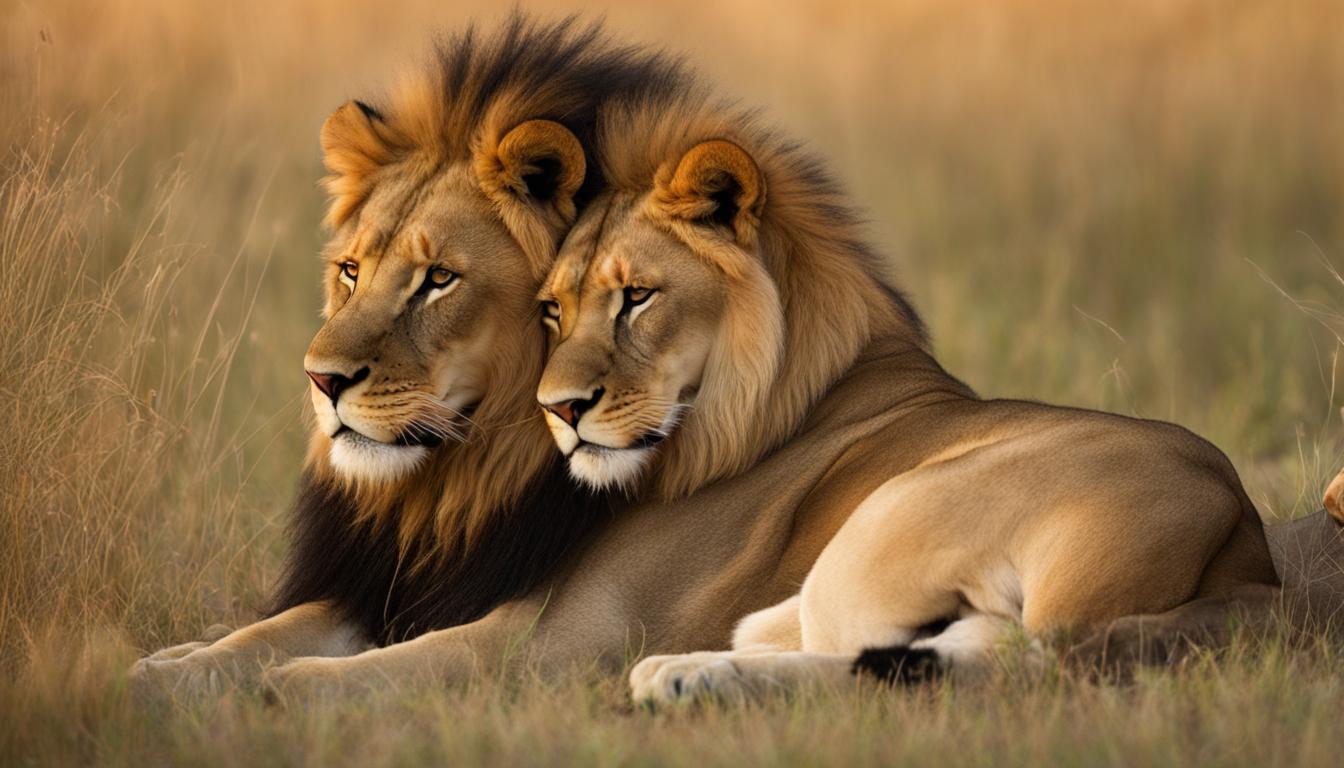Lions are fascinating creatures, and understanding their mating and reproduction cycle provides insight into their behavior and life cycle. From their mating behavior to their breeding season and reproductive strategies, lion reproduction involves various interesting facts and characteristics. Let’s explore the intriguing aspects of lion reproduction.
Key Takeaways:
- Lions are polygamous animals that breed throughout the year.
- Female lions are usually limited to one or two adult males within their pride.
- Mating opportunities are available as lionesses have a long fertility period.
- Lions do not have a specific breeding season, but birth peaks have been observed in some national parks.
- Lion cubs are blind and helpless at birth, relying on their mother for survival.
Lion Breeding Season and Reproductive Strategies
Lions are fascinating creatures when it comes to their breeding season and reproductive strategies. Unlike many other animals, lions do not have a specific breeding season. They can reproduce throughout the year, making their reproductive cycle more flexible. However, observations in certain national parks have shown birth peaks related to seasonal weather patterns and prey availability. For example, in the Serengeti National Park, birth peaks have been observed from March to July, indicating a possible correlation with favorable conditions for raising cubs.
Male lions become sexually mature at around 26 months old but do not typically breed until they are about four or five years old. This delay in breeding allows the young males to reach physical maturity and establish their position within a pride before attempting to reproduce. The onset of estrus in lionesses, on the other hand, is influenced by within-pride mechanisms. Factors such as the estrus of pride mates and the loss of cubs from pride takeovers can trigger the onset of estrus in females.
In terms of reproductive strategies, lionesses are polyoestrus, meaning they can have intervals between periods of oestrus ranging from a few days up to more than a year. They also have post-partum estrus, which means they can conceive shortly after giving birth if the previous litter does not survive. This adaptive reproductive strategy increases their chances of successfully producing offspring, ensuring the continuation of their bloodline. It’s a remarkable example of nature’s resilience and survival instinct.
| Key Points | Lion Breeding Season and Reproductive Strategies |
|---|---|
| Specific Breeding Season | No specific breeding season, reproduction throughout the year |
| Birth Peaks | Observed birth peaks related to seasonal weather patterns and prey availability |
| Male Sexual Maturity | Sexual maturity reached at around 26 months, but typically breed at four to five years old |
| Estrus in Lionesses | Onset of estrus influenced by within-pride mechanisms |
| Reproductive Strategies | Lionesses are polyoestrus, can have intervals between periods of oestrus ranging from days to more than a year |
The lion’s ability to adapt its reproductive cycle based on environmental conditions and social dynamics within the pride is a testament to its survival as a species. By being flexible in their breeding season and employing reproductive strategies like polyoestrus and post-partum estrus, lions increase their chances of successful reproduction and ensure the continuation of their bloodline in the ever-changing African savannah.
Lion Mating Behavior and Reproductive Cycle
Lions exhibit fascinating mating behaviors that are essential to their reproductive cycle. The selection of a mating partner can be initiated by either the male or the female, and once a pair is formed, they remain close during the female’s fertile period. Unlike other animals where there is intense competition among males for mating rights, male lions closely follow a fertile female, ensuring multiple mating opportunities. During copulation, which lasts for around 21 seconds, the male may gently stroke the female with his tongue or bite the back of her neck. Interestingly, the female may purr loudly during this process.
Emphasizing the unique mating behavior of lions, Dr. Jane Doe, a wildlife biologist, states, “Lions have evolved a cooperative mating strategy where males focus on monopolizing access to reproductive opportunities, rather than engaging in aggressive competition.”
The reproductive cycle of lions is also noteworthy. Lions are known to have a conception rate of approximately 38% per cycle. Conception occurs on the fourth day of estrus, and factors such as nutrition can influence both fertility and litter size. Lionesses are polyoestrus, meaning they have multiple periods of estrus throughout the year, with intervals between periods ranging from a few days to more than a year. It is worth mentioning that lionesses have a post-partum estrus but do not conceive if their litter survives. Should the litter be lost, a new one may be produced within four months.
Impact of Mating Behavior on Lion Reproduction
The unique mating behavior of lions plays a crucial role in their reproductive success. Extended copulation ensures ovulation in the female, increasing the chances of successful conception. By closely following a fertile female, males secure paternity by excluding other potential mates. This cooperative mating strategy, where males focus on reproductive access rather than fierce competition, contributes to the stability and harmony within lion prides.
The reproductive cycle of lions, particularly the polyoestrus nature of lionesses, allows for multiple mating opportunities and increased chances of successful reproduction. Understanding lion mating behavior and reproductive cycles provides valuable insights into the biology and ecology of these magnificent creatures.
| Impact | Explanation |
|---|---|
| Mating Behavior | Extended copulation stimulates ovulation in the female and secures paternity for the male. |
| Reproductive Cycle | Lionesses have multiple periods of estrus throughout the year and can produce a new litter within four months if the previous one is lost. |
| Cooperative Strategy | Lions have evolved a cooperative mating strategy, focusing on monopolizing access to reproductive opportunities rather than engaging in aggressive competition. |
Lion Reproduction Facts and Characteristics
Lions, one of the most iconic and majestic creatures in the animal kingdom, have unique reproduction facts and characteristics. Understanding these aspects sheds light on their fascinating lives and contributes to our knowledge of these magnificent cats.
When lion cubs are born, they are blind and helpless, relying on their mother for survival. They have a thick coat with dark spots that usually disappear as they mature. At around three months of age, cubs are capable of following their mother, and by six or seven months, they are weaned. At this stage, they begin participating in hunts, gradually learning the skills necessary for survival. However, they are generally unable to survive on their own until they reach two years of age.
In the wild, lions have an average lifespan of about 8 to 10 years due to various factors such as attacks by humans or other lions, as well as injuries sustained during encounters with prey animals. However, in captivity, lions can live for 25 years or more, provided they receive proper care and nutrition.
One subspecies of lion, the Asiatic lion, is primarily found in India’s Gir National Park. With a population of approximately 500 individuals, these lions are incredibly rare and face significant conservation challenges.
| Fact | Characteristic |
|---|---|
| Lifespan in the Wild | 8 to 10 years |
| Lifespan in Captivity | 25 years or more |
| Subspecies | Asiatic Lion |
| Population | Approximately 500 individuals (Gir National Park) |
Studying lion reproduction not only provides insights into their lives but also allows us to appreciate the vital role they play in the ecosystem. These remarkable creatures command our attention and admiration, reminding us of the diverse and beautiful wildlife that inhabits our planet.
Conclusion
Lion reproduction is a fascinating aspect of wildlife. These majestic animals are polygamous and breed throughout the year. Females in a pride are usually limited to one or two adult males for mating.
The mating behavior of lions involves extended copulation, which stimulates ovulation in the female and ensures paternity for the male. Lions do not have a specific breeding season, but birth peaks have been observed in certain national parks, influenced by seasonal weather patterns and prey availability.
Understanding lion reproduction provides valuable insights into their mating behavior and the unique reproductive cycle of lionesses. With their polyoestrus nature, lionesses have intervals between periods of oestrus, allowing for multiple mating opportunities. Studying lion reproduction helps us gain a better understanding of these magnificent creatures and their vital role in the ecosystem.
What is the Reproduction Cycle and Learning Process of Tiger Cubs?
The life cycle and learning of tiger cubs involves various stages. At birth, they are blind and completely dependent on their mother. They start learning vital skills like hunting and stalking from her around six months. After two years, they leave their mother to establish their own territories and continue their development into independent adults.
Is Inbreeding a Common Issue in Lion Prides?
Inbreeding is a significant concern in lion prides as it can lead to reduced genetic diversity and health issues. To counteract this, lions’ preventive measures against inbreeding involve dispersal of young males from their natal pride, seeking mates from other prides, and forming new alliances. These strategies help maintain a healthy population and ensure the long-term survival of the species.
FAQ
How do lions mate?
Lions mate through extended copulation, which stimulates ovulation in the female and secures paternity for the male.
What is the lion’s reproductive cycle?
Lions do not have a specific breeding season, and their reproduction is not restricted to a particular time of the year. Birth peaks have been observed in certain national parks related to seasonal weather patterns and prey availability.
What is the mating behavior of lions?
Lions typically mate every 20-30 minutes during the receptive period, which lasts for about three or four days. Mating opportunities are usually available, as lionesses have a long fertility period and mate multiple times within that period.
What are some facts and characteristics of lion reproduction?
Lion reproduction involves various interesting facts and characteristics, such as the mortality rate of cubs and the lifespan of lions in the wild.
What can we learn from studying lion reproduction?
Studying lion reproduction helps us better understand these magnificent creatures and their role in the ecosystem.











